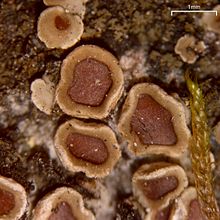
Aspicilia is a genus of mostly crustose areolate lichens that grow on rock. Most members have black apothecia discs that are slightly immersed in the areolas, hence the common name"Given the same reason, the naming of Aspicilia is derived from the Greek word for "shield concave".

The Acarosporaceae are a family of fungi in the order Acarosporales. Members of this family have a widespread distribution, and are mostly lichenized with green algae. According to a 2021 estimate, the family contains 11 genera and about 260 species. The family is characterised by a hamathecium formed of paraphysoids.

Lecanora is a genus of lichen commonly called rim lichens. Lichens in the genus Squamarina are also called rim lichens. Members of the genus have roughly circular fruiting discs (apothecia) with rims that have photosynthetic tissue similar to that of the nonfruiting part of the lichen body (thallus). Other lichens with apothecia having margins made of thallus-like tissue are called lecanorine.

Toninia is a genus of lichen-forming fungi in the family Ramalinaceae.
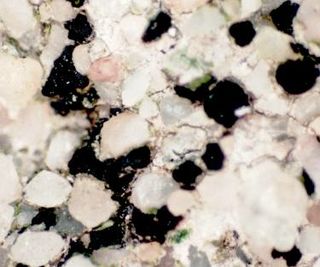
Sarcogyne is a genus of crustose lichens in the family Acarosporaceae. It was circumscribed by German botanist Julius von Flotow in 1850. A proposal has been put forth in 2021 to assign Sarcogyne clavus as the type species of the genus, "as it represents the original concept of Sarcogyne as having melanized lecideine apothecia without algae in the margin".

Stigmidium is a genus of lichenicolous (lichen-eating) fungi in the family Mycosphaerellaceae. The genus was circumscribed by Italian botanist Vittore Benedetto Antonio Trevisan de Saint-Léon in 1860, with Stigmidium schaereri assigned as the type species.

Heteroplacidium is a genus of lichen-forming fungi in the family Verrucariaceae. The genus was circumscribed by Austrian lichenologist Othmar Breuss in 1996 with Heteroplacidium imbricatum assigned as the type species. It was proposed as a segregate of Catapyrenium. Other morphologically similar genera are Neocatapyrenium, Placidium, and Scleropyrenium, although molecular phylogenetic analyses indicate that they are independent monophyletic lineages within the Verrucariaceae.

Peltula is a genus of small dark brown to olive or dark gray squamulose lichens that can be saxicolous ) or terricolous. Members of the genus are commonly called rock-olive lichens. They are cyanolichens, with the cyanobacterium photobiont from the genus Anacystis. They are umbilicate with flat to erect squamule lobes that attach from a central holdfast or cluster of rhizenes. Lichen spot tests are usually negative.

Acarospora socialis is a usually bright yellow areolate to squamulose crustose lichen in the family Acarosporaceae that grows up to 10 cm wide, mostly on rock in western North America. It is among the most common lichens in the deserts of Arizona and southern California. It grows on sandstone, intrusive and extrusive igneous rock such as granitics, in all kinds of exposures to sunlight, including vertical rock walls. It is found in North America, including areas of the Mojave Desert and Sonoran Desert region, to Baja California Sur. It is the most common yellow member of its genus in southwestern North America. It sometimes, but rarely, grows on other soil crusts. It is a pioneer species.
Caloplaca durietzii, or Durietz's orange lichen, a smooth surfaced yellowish orange crustose areolate lichen with elongated lobes that grows on wood or bark in southwestern North America. It is commonly seen growing on old junipers in Joshua Tree National Monument in the Mojave Desert. It is in the Caloplaca fungus genus of the Teloschistaceae family.

Acarospora fuscata is a glossy pale or yellowish-brown areolate lichen with angular areolas that grows up to 10 cm (4 in) wide on non-calcareous rock in low and high elevations. It grows in Europe and North America. It grows in southern California and on the eastern part of the Sierra Nevada range. It may grow with the areolas disconnected. The areolas may lift at the edges, but the areolas do not overlap like true squamules (sub-squamulose). More common in the Sierras is the similar species Acarospora thamnina, which is truly squamulose with overlapping scales.
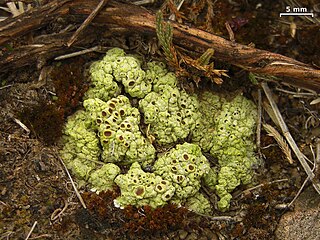
Acarospora schleicheri, the soil paint lichen, is a bleached to bright yellow areolate to squamulose lichen that commonly grows to 10 cm (4 in) on soil (terricolous) in arid habitats of southern California and Baja California, also in Europe and Africa. It produces rhizocarpic acid as a secondary metabolite, which gives it a yellow coloration and serves to protect it from the sun. Its lower surface is also yellow. It can be greenish when moist. Roundish, angular, or irregularly shaped squamules are 0.5–4 mm in diameter. There are 0–1 apothecia embedded in the thallus, with 0.4–1.2 mm roundish black to reddish-brown, or dark brown discs, which sometimes fill the areola so as to be lecanorine. It divides vegetatively on the soil. Asci are club shaped (clavate) and have 100 or more spherical to ellipsoid spores. Lichen spot tests are negative, and it is UV+ orange under ultraviolet light.
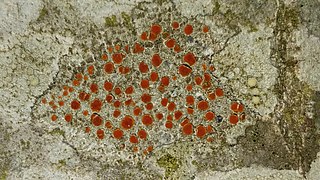
Blastenia is a genus of lichen-forming fungi in the family Teloschistaceae. The genus was circumscribed in 1852 by Abramo Bartolommeo Massalongo.

Xanthocarpia is a genus of mostly crustose lichens in the family Teloschistaceae. It has 12 species with a largely Northern Hemisphere distribution.
Silobia rufescens is a lichenized fungus, with a dark gray or brown crust-like appearance. It is widespread, and grows on siliceous rock. S. rufescens is in the genus Silobia, which is segregated from the genus Acarospora due to its budding apothecia with only lateral exciple.
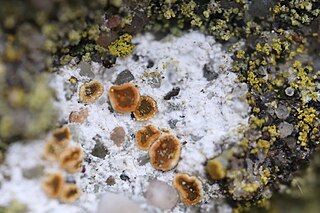
Kuettlingeria is a genus of saxicolous (rock-dwelling), crustose lichens in the family Teloschistaceae. Species are characterized by a white or gray thallus and the presence of anthraquinones in the apothecial disc and true exciple, with the exception of Kuettlingeria diphyodes, which entirely lacks anthraquinones. First described by Italian botanist Trevisan in 1857, the genus includes 15 recognized species, although it is believed to be more diverse with additional unnamed species. These lichens are predominantly found in the Northern Hemisphere, particularly in the Mediterranean region, and grow on limestone and base-rich siliceous outcrops in sunlit conditions.
Acarospora dissecta is a species of saxicolous (rock-dwelling), crustose lichen in the family Acarosporaceae. It grows on volcanic rock in high-altitude regions of the Andes. Its distinguishing features include a crust-like formation of dispersed areoles, a unique combination of organic acids, and a distinctive fissuring pattern. This lichen thrives in the semi-desert, high Andean areas, and currently, its known distribution is limited to specific areas in Bolivia.
